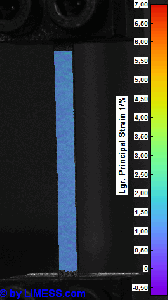Interpreting Stress-Strain Diagrams
A Stress-Strain Diagram gives you information on how a specific material deforms under an applied stress. Even though a stress-strain diagram will look slightly different for each material you test, there are certain diagnostic features that are good to keep in mind.

- Linear Elastic Regime: Stress is linearly proportional to strain up to the yield strength (red circle). Any deformation within this regime is elastic so the material will recover its original form if the stress is removed. The slope in the linear elastic regime is referred to as Young’s Modulus (γ) and describes how much resistance the material will put up against imposed deformation.
- Yield Strength (red circle): The point where the deformation becomes permanent (plastic deformation) even if the stress is removed.
- Ultimate Strength (green circle): The ultimate (usually tensile) stress that a material can use to resist imposed deformation
- Fracture (open circle): The material breaks
By integrating the stress over a the strain to the yield strength, you calculate the amount of energy that can be stored elastically (i.e. the Modulus of Resilience) . If you continue the integration over the entire strain to the fracture point, you have calculated the energy required to break the material.
In metals, there is an interesting phenomena where there is a local minimum in the stress following the yield strength. The material will then undergo strain hardening where as the stress increases the metal will respond with the formation of Lüders Bands, where an increase in strain will not produce an increase in stress (slope is close to zero). After passing the ultimate strength, the metal will begin necking (cross-sectional area will thin in a local region) and fracture at the region where the necking has been most extreme.
Stress-Strain Diagram for a Ductile Metal

Formation of Lüders Bands (measured by digital image correlation from LIMESS). Credit: Errel67
One thing to keep in mind: the strain is considered the independent variable here because in the process of stress-testing materials, you are forcing the material to deform and measuring the force of resistance this requires.